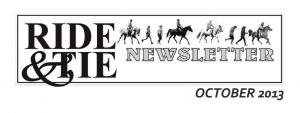Ride and Tie Essay – ONLINE!
| March 20, 2014 | Posted by Melinda under Ride and Tie, Uncategorized |
It’s up!!!!
Out of courtesy for my essay being chosen for publication in the Ride and Tie newsletter I did not republish it here. The article published in the Oct 2013 edition, but the pdf of the issue didn’t come online until the last couple of days.
My article is on pages 8-9. It’s the first time (if you don’t count my “why I want to go to college/why I want to be a vet” essays) that I’ve ever earned money for something I wrote. I adore writing and especially writing about topics that help educate people into being able to make their own educated decisions, rather then me telling them exactly what to do. Maybe one day when I’m Melinda Faubel, DVM I can make a couple bucks here and there writing these sorts of things.
Even if you suffered through my heat conditioning blog posts last summer, you might want to give the article a read through – I took 4 or 5 wordy posts, condensed it down to a 1000 words of essential information. I took out much of the specific “how to’s” and what I did with Farley so if you are interested in that information, do a search on the blog.
(Did anyone else notice that Tess managed to photobomb my article? I swear it was completely by accident. They asked me for several pictures and they chose which ones they wanted to use – they cropped some and left others full size. They cropped the one of me and my partner at our ride and tie with her horse….but Tess got a full sized image. LOL. That dog cracks me up…..)
They didn’t publish the reference that were submitted as part of the requirements for the essay, so here they are if you are interested:
Brengelmann, G. (1998). Normal Body Temperature and Thermal Neutrality. University of Washington, Physiology and Biophysics. Retrieved July 01, 2013, from http://faculty.washington.edu/brengelm/neut_zone/pg1.html
Geor, R. J., McCutcheon, L. J., Ecker, G. L., & Lindinger, M. I. (2000). Heat storage in horses during submaximal exercise before and after humid heat acclimation. Journal of Applied Physiology, 89(6), 2283–2293.
Hinchcliff, K., & Geor, R. (2008). Equine Exercise Physiology: The Science of Exercise in the Athletic Horse. (1st ed.). Saunders Elsevier.
Kennedy, M. W. (2011). Latherin and other biocompatible surfactant proteins. Biochemical Society Transactions, 39(4), 1017–1022.
Marlin, D. J., Scott, C. M., Schroter, R. C., Harris, R. C., Harris, P. A., Roberts, C. A., & Mills, P. C. (1999). Physiological responses of horses to a treadmill simulated speed and endurance test in high heat and humidity before and after humid heat acclimation. Equine Veterinary Journal, 31(1), 31–42.
McConaghy, F. F., Hodgson, D. R., Evans, D. L., & Rose, R. J. (1995). Equine sweat composition: effects of adrenaline infusion, exercise and training. Equine Veterinary Journal Supplement, 20(20), 158–164.
McCutcheon, L. J., & Geor, R. J. (2000). Influence of training on sweating responses during submaximal exercise in horses. Journal of Applied Physiology, 89(6), 2463–2471.
McCutcheon, L. J., Geor, R. J., Ecker, G. L., & Lindinger, M. I. (1999). Equine sweating responses to submaximal exercise during 21 days of heat acclimation. Journal of Applied Physiology, 87(5), 1843–1851.
McCucheon, L. J., Geor, R. J., Hare, M. J., Kingston, J. K., & Staempfli, H. R. (1995). Sweat composition: comparison of collection methods and effects of exercise intensity. Equine Veterinary Journal, 27(S18), 279–284.
McDonald, R. E., Fleming, R. I., Beeley, J. G., et al. (2009). Latherin: A Surfactant Protein of Horse Sweat and Saliva. PLoS ONE, 4(5), 12.
McKeever, K. H., Eaton, T. L., Geiser, S., Kearns, C. F., & Lehnhard, R. A. (2010). Age related decreases in thermoregulation and cardiovascular function in horses. Equine Veterinary Journal, 42 Suppl 3(38), 220–227.












Congrats! I must not have read the first round of info very well because I learned something from the article:)
Oh oh oh! Now you have to tell me what you learned!!! 🙂
It was the info about how horse’s sweat has latherin in it, so that the sweat won’t just roll off the coat. I curse that water-repellant nature whenever I try to give my horse a bath, especially in winter when it takes at least 2 shampoos to penetrate the filth (and now I know why the shampoo works – it’s because of the surfactant not because it got rid of the dirt). I feel super smart today!
OOOOOOHHHHH that is very smart indeed 🙂
Thank you!!!! Compliments for aarene on writing stuff makes my day 🙂
Great essay, good info, very readable.
And I love the picture of Tess. 🙂
One thing I learned when I saw it in print – is that sometimes the publisher doesn’t keep your same paragraph breaks because it doesnt’ work with the formatting of the article. The original was much easier to read because there was a line space between the paragraphs. I’ll keep that in mind as I write my submission for this year (although the panel reads it in my original format, so probably more important if I do articles in the future where the end stage formatting is more important than the initial).
Nicely done in a thousand words. It’s so hard to be succinct!!